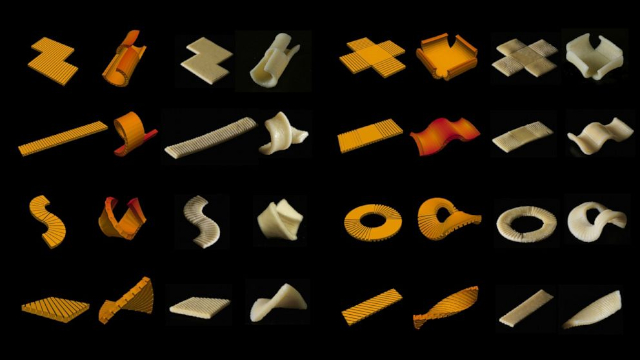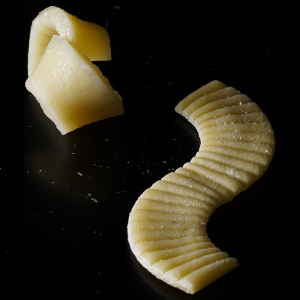I just love those old-timey tabloid headlines! And how seldom do I get to use them! Anyway… A research team in the U.S. has figured out a way to create pasta (all shapes and sizes) like IKEA furniture, to save on packaging and shipping costs. It’s a fascinating process, and I’d buy ‘flat-packed pasta’ at least once just to watch it cook up into shape!
 Just few of the shapes the researchers at Carnegie Mellon have made
Just few of the shapes the researchers at Carnegie Mellon have made
using their new grooving/scoring technique. The sky’s the limit!
I was rambling aimlessly around the web earlier this morning when I came across a reference to an Inside Science story about ‘flat-pack pasta’. I immediately thought of pasta that came in a plain brown cardboard box and required some assembly. I know. I’ve been in lock-down too long. My brain is going googoo looking for legitimate stimulation.
Anyway…
Their motivation
Scientists at Carnegie Mellon University’s University’s Morphing Matter Lab in Pittsburgh thought it would be great – for a number of good reasons – if pasta could be manufactured to ship flat and then assume its familiar shapes during cooking.
“Food packaging is one of the biggest sources of waste in the world,” said Study Senior Author Lining Yao. “Our flat-packed pasta could save more than 60 percent of the packaging space [required by] conventional pasta while still having the same mouthfeel, flavor and texture.”
The pasta we’re used to – invented hundreds of years ago – changes shape (a little) and softens and swells up when cooked. Why not, researchers hypothesized, use these natural predispositions to help create something useful?
Feelin’ groovy
According to the Inside Science story: “The researchers stamped patterns of tiny grooves into conventional flat pasta dough made solely of semolina flour and water. The grooves increased how long it took boiling water to cause those areas to swell. By controlling the angle, width, depth and spacing of the grooves, they could make flat pasta fold into tubes, spirals, twists, waves and boxlike shapes when cooked.”
The folding and curling action takes place in stamped pasta during cooking because the density of the pasta in the grooves differs from that of the regular flat pasta. The compressed grooves absorb water more slowly than the surrounding pasta causing unequal swelling that presents itself as curling and folding, depending on the patern and depth of the grooves. (See example, in photo, top of page.)
Applications abound
Yao foresees flat-pack pasta being used by hikers and even space travellers, thanks to its dramatically-reduced requirement for packing and shipping space. More immediately, they see savings of billions in packaging costs for pasta – one of the world’s most popular foods – not to mention a huge reduction in pasta packaging pollution. So, you see? There’s much more to this discovery than just watching flat pasta turn into Fusilli, Penne and Orecchiette.
I can see pasta companies offering special edition Animal or other pasta shapes, or arranging collaborations with other brands resulting in the appearance of 3-D figures of popular animated characters and other shapes in your pasta bowl – after cooking. It used to be that Pillsbury promoted the ‘fun’ you and your kids could have watching their dinner rolls and other pastries rise and brown in the oven. The next big thing could be Pasta Pals!
Remember Willy Wonka’s Golden Tickets? Pasta makers could stage contests by placing special, limited-edition self-assembling pasta shapes in their flat-pasta packages. Contest winners wouldn’t know if they had a ‘winning’ pasta shape until they poked through their plate! Thanks to the magic of camera phones and the internet, ‘winners’ could register their ‘finds’ on the spot and be entered in the grand prize draw… Yah, I know I’m fugueing, here, a bit, but…
Back to the serious side for a moment…
I can see how this technique, allowing shaped pasta to be packed flat, would save a lot of money and – probably – a lot of manufacturing hassle (and cost?) Could the pasta makers throw out all their expensive extrusion and other shaping machines in favour of a couple of grooving stampers for which they would just have to change stamping dies to make different products?
Would the already reasonable price of pasta come down further? Probably not. But it might not go up (as the price of all food ultimately does) quite as quickly.
For me, I think it will take a long time for just watching the magical shapes appear during cooking to get old. How glad am I, now, that I bought that set of copper-bottomed pots and pans a few years back – with the glass lids!
~ Maggie J.

